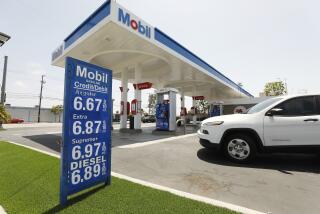Power Breakthrough : Energy: Southern California Gas Co. launches the first commercial application of fuel-cell-generated electricity.
- Share via
A promising alternative energy source leaves the test workbench today as Southern California Gas Co. shows off the nation’s first commercially operating fuel cell and a business-government coalition calls for a $1-billion effort to adapt the technology for use in autos, buses and trains.
Proponents of fuel cells, which operate like big batteries, say the technology could eventually be used for everything from the family car--and house--to electrical power plants for entire cities.
The SoCal Gas fuel cell will use natural gas to produce 200 kilowatts of electricity at the Diamond Bar headquarters of the South Coast Air Quality Management District.
At the same time, the AQMD is launching an ambitious effort to develop smaller fuel cells for motor vehicles and trains, with the goal of mass production by the year 2001.
The Ad-Hoc Coalition on Fuel Cells for Transportation, a consortium of business and government agencies spearheaded by the AQMD, hopes to collect $550 million from private and public sources--with $450 million in federal matching funds--for the small fuel-cell program.
Clean-running vehicles are of particular importance to Southern California, which faces increasingly stringent air-pollution regulations in the next decade.
The fuel cell traces its origins to a British scientist’s experiments in 1839. But much of the practical engineering was done in the 1960s, when NASA developed the technology as the lightweight power source for U.S. space vehicles, including the space shuttle.
A fuel cell combines oxygen from the air with hydrogen--in this case, extracted from natural gas--to produce water, electricity and heat.
The fuel cell is less polluting than most conventional energy generation methods because no combustion takes place. The SoCal Gas fuel cells emit virtually no nitrogen oxide and about a quarter less carbon dioxide than power plants that use fossil fuels. (Other systems under development show even more pollution savings.) Fuel cells can also be twice as efficient as conventional energy sources and, because they use no moving parts, are quiet.
Environmentalists generally like the technology, though in the long-term many would prefer sources other than non-renewable natural gas to produce the hydrogen.
SoCal Gas’ phosphoric acid version of the fuel cell, manufactured by International Fuel Cells, a United Technologies subsidiary in South Windsor, Conn., is similar to technology in use at some big Japanese power plants.
Pacific Gas & Electric Co., in Northern California, has successfully run a 20-kilowatt demonstration model of a different fuel-cell technology--termed the molten carbonate fuel cell--for almost a year in its San Ramon research facility.
Industry has long been concerned about the price, durability and unproven technology of fuel cells.
Price has been the biggest drawback: Fuel cells still cost 2 1/2 times more than conventional electric power sources, according to the gas company.
But the SoCal Gas version “is kind of the only game in town,” said Rocky Goldstein, project manager of fuel cell technology at the Electric Power Research Institute in Menlo Park. “Everything else is under development.”
Future generations of fuel cells, Goldstein said, will be cheaper and more efficient. A commercial version of the molten carbonate fuel cell, a second-generation design, could be available as early as 1997, he said.
The AQMD fuel cell--which could provide electricity and hot water for a 30-unit apartment and swimming pool--costs $3,000 a kilowatt. That compares to $1,000 to $2,500 for new conventional power sources.
But SoCal Gas and other proponents say the cost of the fuel cells should drop once they are mass-produced, making them more competitive with conventional power sources.
For now, the utility has sweetened the deal for the first 10 fuel-cell installations at Southern California businesses by offering an “energy service agreement.” SoCal Gas will own, operate and maintain the cells, while the companies pay only for the natural gas, plus some installation and upkeep.
The next nine installations, beginning later this summer, include a Hyatt Hotel in Irvine, the Santa Barbara County jail, Kraft Foods in Buena Park, the central control facility for the Metro Rail Blue Line and Kaiser Permanente hospitals in Anaheim and Riverside.
The Natural-Gas Powered Fuel Cell System:
Fuel cells basically operate like batteries that do not run down. Pure water and heat the byproducts that are recycled to the fuel processor as steam, increasing energy efficiency to more than 80% compared to roughly 34% for conventional fossil-fuel power generators. Air pollution is substantially reduced as well. The fuel cell produces about 24% less carbon dioxide than conventional power plants and almost no nitrogen oxide ---- both greenhouse gases.
Designed particularly for such mid-size 24-hour businesses as hotels and health spas, the 200-kilowatt fuel cell that Southern California Gas is marketing is about the size of a small auto trailer and provides enough energy to power a 30-unit apartment building with swimming pool.
Fuel Processor
Natural gas is separated into hydrogen and carbon dioxide in the fuel processor unit by heat and catalyst
Power Section
Hydrogen is converted to hydrogen ions and electrons at the anode
Hydrogen ions and electrons move across the electrolyte to the cathode
Oxygen, hydrogen ions and electrons are converted to water and heat
Inverter
Electricity is transformed from direct current (DC) to alternating current (AC) for electricity needs
How a Fuel Cell Compares to a Fossil-Fueled Power Plant
Energy Efficiency
Fuel Cell: 82%*
Power Plant: 34%
Carbon Dioxide Emissions
In pounds per megawatt hour
Fuel Cell: 1130
Power Plant: 1485
Nitrogen Oxide Emissions
In pounds per megawatt hour
Fuel Cell: 0.02
Power Plant: 5.74
* Electric generation: 42%, Heat recovery: 40%
More to Read
Inside the business of entertainment
The Wide Shot brings you news, analysis and insights on everything from streaming wars to production — and what it all means for the future.
You may occasionally receive promotional content from the Los Angeles Times.










